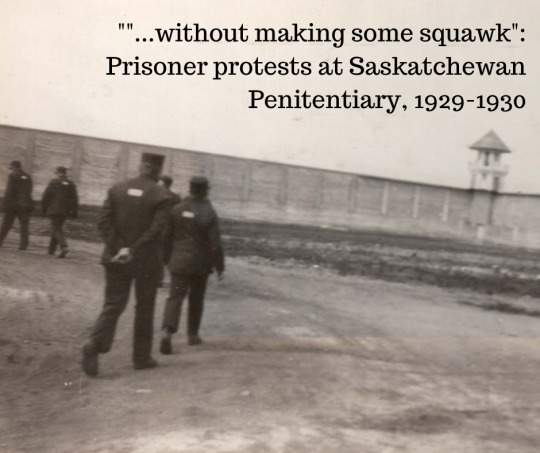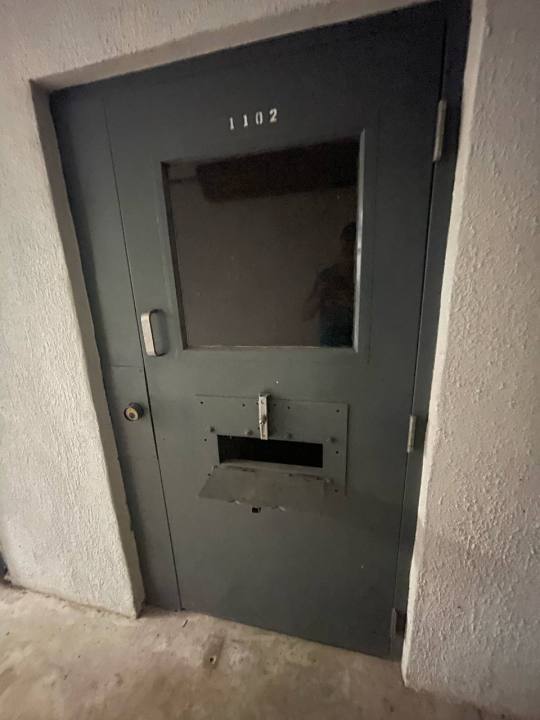#prison administration
Text
Inside and Outside: Wolves and Punks
Early-twentieth-century observations of sex between prisoners were shaped by a burgeoning sexological literature whose conceptual categories proved useful in understanding and mapping prison sexual culture. But heightened attention to prison sex in the 1920s and 1930s, on the part of penologists, prison administrators, and prisoners themselves, is not explained simply by the availability of a new conceptual template. While sexologists puzzled over the etiology of same-sex practices performed by apparently "normal" people, those practices would have been more easily and readily comprehended in urban working-class communities of the period.
George Chauncey has documented the visibility of queer life in early-twentieth-century New York City and its integration in working-class and immigrant communities. In that world, Chauncey writes, "the fundamental division of male sexual actors... was not between "heterosexual' and 'homosexual' men, but between conventionally masculine males, who were regarded as men, and effeminate males, known as fairies or pansies, who were regarded as virtual women, or, more precisely, as members of a 'third sex' that combined elements of the male and female.
Prisons were enclosed communities that gave rise to and perpetuated their own distinctive cultures, but they were far from hermetically sealed. The attribution of sexual deviance or "queerness" to the gender transgression of "fairies" and the possibility of conventionally masculine men having sex with them without compromising their status as "normal" found an echo in men's prison populations. Prison vernacular, especially the terms used to denote participants in prison sex, overlapped closely with working-class vernacular and the roles and expectations it delineated, no doubt reflecting its importation into prisons by a disproportionately working-class inmate population and perhaps its exportation into working-class communities as well.
Prison sexual vernacular was part of a prison argot that attracted considerable attention more generally, from both prison insiders and outsiders. Industrial Workers of the World (IWW) organizer and prisoner Hi Simons was fascinated by prison language that seemed to him "full of swagger and laughter, because of the vivid if often violent and vile poetry that streaked through it.... To use it," Simons wrote, "made us feel bold and free." Simons acknowledged that "except for a few terms from the I.W.W. vocabulary," incarcerated labor organizers "added nothing" to the specialized vocabulary of prisoners, but he worked to compile a dictionary of "prison lingo" he learned while an inmate of the U.S. Disciplinary Barracks at Fort Leavenworth and published it in 1933. Others in this period published glossaries of prison terms as well, testifying to the emergence of a collective consciousness and shared culture among prisoners.
Central to prison argot were the coded terms that delineated sexual types and declared expectations about sexual acts and roles, offering a vernacular analog to sexological taxonomies. Noel Ersine included eighteen terms referring to same-sex sex among the fifteen hundred entries in Underworld and Prison Slang, published in 1933. Simons imagined that "a complete prison dictionary" would constitute "an encyclopedia of all imaginable sexual deviations," rivaling the sexologists' ambitions in cata loging sexual variance."
Prison constituted a unique transfer point between expert and vernacular sexual discourses, the terms of one often inflecting the other. Those men typed by sexologists as "pseudo-homosexuals" or "semi-homosexuals" were known to male prisoners as "wolves" and "punks." Those were men whose participation in same-sex sex was presumed to spring not from their nature but from the exigencies of circumstance. Wolves, sometimes also referred to as "jockers," were typically represented as conventionally, often aggressively masculine men who preserved (and according to some accounts, enhanced) that status by assuming the "active," penetrative role in sex with other men. As Victor Nelson made clear, "The wolf (active sodomist)... is not considered by the average inmate to be 'queer' in the sense that the oral copulist... is so considered. " In contrast to many accounts by penologists and some prison officials who blamed fairies for prison seduction, those most familiar with prison life typically credited wolves with initiating sex behind bars.
That initiation was often aggressive. As their name suggested, wolves were understood to be sexual predators, wooing, bribing, and sometimes forcing other men to have sex with them. Wolves were "always on the lookout for a handsome boy with a weak mind, who had nobody to send them in some food and money," sociologist Clifford Shaw wrote in his 1931 case study of a young juvenile delinquent." Berg described the process by which the wolf secured a sexual partner as "a campaign in which all the luxuries of prison - candy tobacco, sweets, and choice foods - are pressed upon the newcomer." Once the object of the wolf's affection accepted the goods offered, "he is quickly given to understand that he must repay the favor in kind." Sometimes seduction by wolves was described as a deliberate and cold-hearted maneuver of engaging a younger inmate in a relationship of indebtedness, which could be repaid only by sex. Others offered examples of more heartfelt and romantic courtship. Nelson recalled "Dreegan," the "champion "wolf" at Auburn Prison," who
outrageously flattered the objects of his lust; he gave them cigarettes, candy, money, or whatever else he possessed which might serve to break down their powers of resistance; and otherwise courted' them exactly as a normal man 'courts a woman. Once the boy had been seduced, if he proved satisfactory, Dreegan would go the whole hog, like a Wall Street broker with a Broadway chorus-girl mistress, and squander all of his possessions on the boy of the moment.
Wolves may not have been motivated by "true" homosexuality, in the understanding of contemporaries, but the relationships they forged in prison were often far from casual. Jealous rivalries and violent confrontations among inmates were credited to the passionate feelings of some wolves for their partners. Inmate-author Goat Laven described "brutal fights," some fatal, that arose from sexual jealousies: "It means a kick in the back to steal another man's kid." Louis Berg seconded Laven account. "The unwritten law of the prison forbids any 'wolf" to make approaches to another's 'boy friend' once he is wooed and won," Berg observed. "But it is not to be expected that men who break the laws for lesser urges will hesitate when they are driven by passions that rock them to the roots of their being. Fights occur between 'wolves' over some boy which are sanguinary and even end in murder."
Berg went on to recount the murder of "Mildred," an inmate at Welfare Island, by her jealous ex-lover. "From all accounts, Berg observed, "Mildred' was the victim of jealousy caused by 'her' unfaithfulness. That 'she' paid with 'her' life partner. shows the seriousness with which such prison marriages' are regarded." To some, the jealous violence that prison relationships could spark testified not only to depth of feeling but also to their similarity to heterosexual relationships. In a disturbing comparison, Berg concluded that Mildred's murder "proves how completely such relationships are identified with the normal ones between men and women." Charles Ford described jealousies among female inmates that resulted in fist fights, "hair pullings," and "every other conceivable type of trouble making activity" and that were even more real than husband-wife jealousies."
One theory explaining the existence of prison wolves, enshrined in inmate lore by the early twentieth century, proposed that "a 'wolf' is an ex-punk looking for revenge!" The object of wolves' and jocker attentions were known as "punks" and "kids," often identified as younger inmates, unfamiliar with life behind bars and unable or unwilling to defend themselves physically. A type recognized in prison argot at least the early twentieth century, punks were understood to be "normal" men, vulnerable to sexual coercion by other inmates because of the combination of small physical stature, youth, boyish attractiveness, and lack of institutional savvy. A few accounts suggested that punks were potential homosexuals whose latent desires were nurtured and realized the prison context, but most saw them simply as the unfortunate victims of wolves.
The punk's fate was often attributed to naïveté and, especially, his ignorance of the inmate code and the consequences of indebtedness. Charles Wharton wrote in his 1932 prison account of a fellow inmate, "a mere boy" who "seemed to have come direct from a farm" who had "all the bewilderment of a child thrust into strange, frightening surroundings." The youth soon became the object of "pretended interest and sympathy" from other convicts, who showered him with presents, "silk hose, fancy underwear, food stolen from the kitchen, and best of all, cigarets [sic], the gold standard of prison barter." In the process, Wharton wrote, the boy "became a wretched victim of the most vicious circle in Leavenworth's convict population.
Punks also suffered as a result of their youthful good looks. Jim Tully, author of the many books on his experiences on the road as a hobo and time in prison, recalled Eddie, a young inmate "with yellow hair and wondering hazel eyes" who was "too beautiful to be a boy." Eddie's life in prison as a result "was made a constant hardship by sex-starved men." Berg wrote that prison populations always include "boys at that uncertain age where they have a good deal of the feminine in them." Such boys, Berg wrote, "are in most prized in jails and prisons as virgins." Berg also attributed the fate of punks to "biologic inadequacy (another name for lack of guts)."
Whether understood to be the victims of their own attractiveness, their youth and small stature, or their cowardice, punks were never depicted as wholly willing participants in sex with other men. Although there was little attention to overt sexual violence in early-twentieth-century prison writing, many acknowledged that some form of coercion was often involved in sex in prison, in men's prisons especially. Like wolves, punks were also understood under the rubric of "acquired" homosexuality - they participated in sex with other men not because of a constitutional condition but because of the unusual circumstances of prison life. "Had they never gone to prison," Berg wrote ruefully, "most of them would today be normal men."
Prison sexual vernacular and the culture it delineated overlapped particularly closely with that of itinerant laborers, tramps, and hoboes who traveled the country's highways, rural byways, and railroad arteries in the early decades of the twentieth century. The association between tramping and homosexuality was strong enough by 1939 for a textbook on prison psychiatry to warn of "the possibility of homosexuality in prisoners of the vagabond type," since "this tendency among them appears to be very widespread." In his 1923 study The Hobo, sociologist Nels Anderson characterized homosexual practices among homeless men as "widespread and described relationships between older men, known as wolves or jockers, with younger men, referred to as punks, kids, or "prushuns." In transient communities, young men partnered with older, more experienced men who promised to protect them and teach them how to survive life on the road in return for domestic and sometimes sexual favors.
Judging from many accounts, those relationships were often predatory and abusive. Jim Tully, whose experiences as a "road-kid," hobo, circus worker, prisoner, and professional prize-fighter provided the material exper for his twenty-six books, characterized the jocker as "a hobo who took a weak boy and made him a sort of slave to beg and run errands and steal for him." Punks, he reported, "were loaned, traded, and even sold to other tramps." John Good recalled that the "criminal tramps or yeggs" who were his companions on the road in turn-of-the-century Denver "needed a boy to beg and steal for them, and to listen around for information." "These boys are degraded to unnatural uses," Good reported, "as well as trained in the arts of pickpocketing and sneak-thieving." Josiah Flynt, an early participant-observer of transient life, also described relationships between boys and their jockers, in which "abnormally masculine" men take "uncommonly feminine" boys as partners." Those attachments sometimes lasted for years, and boys remained with their jockers until they were "emancipated."
Men who lived on the road and on the economic margins were vulnerable to arrest, and incarceration in jails and prisons was a nearly inevitable experience for hobos, tramps, and transient workers. It is not surprising. then, that the vocabulary of prisoners would borrow closely from that of hobo culture, another nearly uniformly single-sex world populated by working-class men. Some prison terms revealed a direct etymology between hobo and prison terminology. When Jack London was arrested for vagrancy in Niagara Falls in 1894, he was locked up in the "Hobo." "The Hobo," he explained, "is that part of a prison where the minor offenders are confined together in a large iron cage. Since hoboes constitute the principle division of the minor offenders, the aforesaid iron cage is called the Hobo." Hi Simons defined the term "Bo" as both a "hobo" and "boy, catamite" in his dictionary of prison argot. The direction of influence was probably two-way, and some prison terms were no doubt ported into hobo and working-class vernacular as well.
The importation of sexual vernacular, customs, and assumptions about same-sex practices from transient men as well as from a larger ur-working-class world meant that some prisoners were familiar with the sexual culture they found behind bars. Fiction writer Chester Himes, who was sentenced to the Ohio State Penitentiary in 1928, claimed "that nothing happened in prison that I had not already encountered in outside life." Himes grew up in a middle-class African American neighborhood in Cleveland, but youthful desire for excitement drew him to the city's rougher side. In prison, he wrote, "all sex gratification derived sodomy, and I had encountered homosexuals galore around the Matic Hotel and the environs of Fifty-Fifth Street and Central Avenue Cleveland." The many incarcerated men with transient pasts would've been similarly familiar with wolf-punk relationships in prison, which mirrored man-kid relationships on the road.
But while prisons, then as now, were by disproportionately populated by working-class inmates, they drew prisoners from other demographic groups as well, some of whom were unfamiliar with prison sexual terminology and the roles and assumptions it described. The persecution of political radicals under the Espionage and Sedition Acts passed during the First World War and in the wake of the Palmer raids of 1919 resulted in the incarceration of activists in the 1920s, many of whom became vocal and articulate critics of the American prison system while behind bars. These spokespeople for the working class often betrayed their own distance from and naïveté about working-class sexual life in their prison writing, and many were shocked by the sexual life they witnessed behind bars.
Alexander Berkman, for example, was candid in detailing his own prison sexual education in a chapter on an encounter with another prisoner, "Red," a hobo who worked alongside Berkman. When Red announced to Berkman, "you're my kid now, see?" Berkman claimed not to understand him and asked him to explain. Bewildered by Berkman's naiveté, Red exclaimed, "You're twenty-two and don't know what a kid is! Green? Well, sir, it would be hard to find an adequate analogy to your inconsistent maturity of mind." When Red explained to him the practice he termed "moonology," which he defined as "the truly Christian science of loving your neighbor, provided he be a nice little boy," Berkman professed not to "believe in this kid love," and was deeply shocked, protesting that "the panegyrics of boy-love are deeply offensive to my instincts. The very thought of the unnatural practice revolts and disgusts me." The pedagogical question-and-answer structure of this chapter allowed Berkman to tutor his readers in "moonology" while maintaining claims to his own sexual innocence. He may also have intended to contrast Red's perverse sexuality with his own presumably platonic love for another inmate that he described later in the memoir. But Berkman was far from alone among early-twentieth-century inmate narrators in professing innocence of same-sex sexuality before life behind bars.
When attorney and former Illinois state congressman Charles S. Wharton was sentenced to two years in Leavenworth penitentiary in 1928 for conspiracy in armed mail robbery, he acknowledged his own pre-prison innocence. Prefacing his discussion of "the worst of all phases of prison life," which he attempted to describe "as delicately as possible," Wharton wrote that, "looking back, I felt that I had been everywhere, seen everything, done about all which the average man-about-town is expected to do, and I held that impression until Leavenworth made me feel like a country yokel staring slack-jawed at his first sight of urban sin."
Socialist and anti war activist Kate Richards O'Hare was similarly shocked and appalled by the homosexuality she witnessed as an inmate of the Missouri state penitentiary in Jefferson City in 1919-20. Scoffing at O'Hare's estimate that 75 percent of her fellow inmates were "abnormal" as "entirely too high," Fishman speculated that she was "naturally led into such an exaggeration because, having no previous personal knowledge of prisons, she was swept off her feet to find that such things existed. She was utterly amazed when I told her that homo-sexuality was a real problem in every prison."
Eugene Debs, who was convicted of violating the Espionage Law in 1918 and sentenced to ten years in prison, lamented that "every prison of which I have any knowledge... reeks with sodomy" and wrote with dismay about "this abominable vice to which many young men fall victims soon after they enter the prison." "I shrink from the loathesome [sic] and repellant task of bringing this hidden horror to light," Debs wrote. "It is a subject so incredibly shocking to me that, but for the charge of recreance that might be brought against me were I to omit it, I would prefer to make no reference to it at all." Debs wrote in near-apocalyptic language about the fate of the boy "schooled in nameless forms of perversions of mind and soul" and prison sexual practices that "wreck the lives of countless thousands and send their wretched victims to premature and dishonored graves."
Whether shocked or inured, prisoners of all stripes acknowledged sex in both men's and women's prison as nearly ubiquitous and its roles and customs elaborated to the point that it constituted a culture unto itself. That culture occupied a curious status in early-twentieth-century prisons. Officially, sex between prisoners was unequivocally forbidden. Prisoners who were found engaging in sex were punished, often by placement in solitary confinement and extension of their sentences. Some prisons took harsh and sometimes draconian measures to distinguish homosexual prisoners from the general population in order to humiliate them and punish their behavior. In the federal penitentiary at Leavenworth, inmates were reportedly forced to wear a large yellow letter D (designating them as "degenerate") if they were discovered having sex.
The superintendent of the Ohio prison at Chillicothe boasted to the director of the Bureau of Prisons, in response to a question about how he handled the problem of "sex perversion" at the institution, that he had found a way to deter such practices through the use of humiliation. "By this I mean that all known perpetrators or anyone anyway connected with sexual perversions be been compelled to sit at a certain table at the mess hall." A report from Kentucky noted that inmates convicted of sexual offenses had one side of their heads shaved to identify them. These practices of marking prisoners as homosexual were forms of punishment for sexual transgression; they also suggested the need for the production of a legible marker of homosexuality that ran counter to the notion that homosexuals, inside and out, were easily identifiable by their gender transgression.
Homosexual prisoners were also dealt physical punishments. A photograph from a Colorado prison depicted two African American prisoners wearing loose dresses, perhaps as another form of stigmatizing market of sexual deviance, and pushing wheelbarrows filled with heavy rocks as a form of punishment for same-sex sex. Kentucky physician F. E. Wylie proposed sterilization and "emasculation" that would "make it impossible for degenerates to commit sex crimes," adding that "surgery might even be used as a punishment" for homosexuality. The authors of an investigation of the Oregon state penitentiary in 1917 moved further to argue that "in cases of congenital homo-sexuality in the penitentiary," the more radical surgery of castration was necessary, to deprive offenders not only of the ability to procreate but of their libido as well. By the 1920s, more than half of the United States had adopted sterilization laws and some targeted "moral degenerates and perverts" specifically. Those laws were most easily and readily applied to people in prisons, mental asylums, and other carceral institutions.
Sex in prison was officially prohibited and sometimes harshly punished. But because of the difficulty of detection and the belief in its inevitability, prison officers often seemed to take it in stride. Joseph Wilson and Michael Pescor criticized prison officers who "regard homosexual practices as only another kind of dirty joke" and wrote that it was "essential that "this question shall always be considered gravely-never with smiles smirks, and a shrug of the shoulder" in their 1939 text on prison psychiatry, suggesting that this was often precisely how it was treated. Berg confirmed that to officials at Welfare Island, "the 'fairies' were, for the most part, simply the butt for lewd jokes. When they spoke of perverts it was with the kind of indulgence that one uses toward children whose peccadillos are amusing rather than serious." He added that "sex indiscretions" were "rarely detected and still less frequently punished."
If prison guards could not be relied on to maintain a properly vigilant and condemnatory attitude regarding prison homosexuality, the some hoped, prisoners themselves would rise to this role. "Only the co-operation of the decent element will ultimately weed them out," Sing Sing warden Lewis Lawes speculated in 1938. Wilson and Pescor went so far as to suggest that if homosexuals "received a reasonable dose of violence" at the hands of prisoners "known to be aggressively heterosexual," it would "help build up a correct prison community attitude towards this question."
But the community attitude in men's prisons, to the extent that it is possible to generalize, seemed often to be characterized by a rough tolerance, even by those who presumably did not participate in same-sex sex. Samuel Roth, who spent several years in prison for publishing what was considered obscene material, noted that "one thing happened immediately," on his incarceration; "I lost my horrors of [homosexuality] as a vice." He was far from alone. Recalling his experience on a Georgia chain gang in the 1930s, George Harsh had "too many other things to think about to care what two consenting adults do between them." "Under the conditions," Harsh wrote, "I think such a situation was inevitable, and I could understand it and condone it." Indeed, the institutional culture of some prisons recognized the established place of prison fairies. Though fairies were segregated in Welfare Island's South Annex, they were allowed to stage a bawdy Christmas show called the "Fag Follies." In later decades, prisons would sponsor football and baseball games that pitted queens against jockers.
- Regina Kunzel, Criminal Intimacy: Prison and the Uneven History of Modern American Sexuality. Chicago: University of Chicago Press, 2008. p. 61-73
#prison slang#convict code#wolves and punks#history of homosexuality#history of heteronormativity#sex in prison#life inside#research quote#reading 2021#hobos#tramps#working class culture#history of crime and punishment#american prison system#victor nelson#chester himes#samuel roth#hi simons#penology#prison administration#queer history
10 notes
·
View notes
Text
More information on Palestinian political prisoners below. Please make sure to check out the thread for links to further content.







3K notes
·
View notes
Text

During her arrest, Ayesh was subjected to assault, threats, and insults by Israeli soldiers, according to the Addameer human rights organisation. She was transferred to Israel’s Hasharon Prison before being later taken to Damon Prison, where she is now being held.
Ayesh’s work as a human rights defender rose to the fore during her time at the Ramallah-based Lawyers for Justice, representing Palestinian political detainees in PA prisons. In July, she attended a session on behalf of the group at the United Nations in Geneva, Switzerland.
Tala Nasser, from the Addameer prisoners’ rights group, explained that Ayesh’s arrest comes amid a “violent mass arrest campaign” carried out by Israel since October 7.
The fact that the vast majority of the more than 6,900 Palestinians arrested in the occupied West Bank and East Jerusalem since October 7 have been transferred to administrative detention highlights the arbitrariness of Israel’s arrests, she said.
“This campaign includes activists, human rights defenders and political leaders,” Nassar told Al Jazeera, noting that it is “an attempt to silence them and prevent the exposure of the occupation’s crimes across the whole country”.
In December, Israeli forces also arrested political and civil society leader Khalida Jarrar, who was similarly transferred to administrative detention.
Despite releasing all but three Palestinian female detainees during the latest prisoner exchange with Hamas at the end of 2023, the Israeli army rearrested dozens. Some 80 female prisoners are being held today, all of whom are in the Damon Prison.
Among the 80 are dozens of women from the besieged Gaza Strip, but lawyers are forbidden from visiting them or knowing anything about them.
Several reports have emerged of female detainees from Gaza being physically beaten and abused, including an unknown number of them being held at Israeli military bases and not in prison.
Lawyers say conditions for all Palestinian detainees, including women, are unprecedentedly difficult. Eight Palestinian male prisoners have also died or were killed in Israeli custody since October 7, most of them in the days and weeks after their arrest.
Over the past few months, many videos have emerged of Israeli soldiers stripping, torturing and abusing male prisoners from both the occupied West Bank and the Gaza Strip.
“It is important to note that every female that is arrested is violated in one way or another,” said Nasser. “They are all facing threats, intensive strip searches, verbal assault and physical violence.”
(continue reading)
#politics#palestine#gaza#diala ayesh#israel#political prisoners#israeli hostages#human rights abuses#administrative detainees
632 notes
·
View notes
Text
AdSeg
Available light photography



It was DARK. No lights/electricity in the abandoned building.
41 notes
·
View notes
Note
Sorry if you’ve already been asked this, but when did you know you wanted to tell Efnisien’s story through FFS? What motivated you to show his redemption journey?
Hi hi anon!
Honestly I started thinking about it during the chapter where Efnisien gives the USB to Augus, and Gwyn tries to kill him, and he's just laughing-crying, while knowing that he's going to be murdered in cold-blood by Crielle as a result.
And then I just...spent about 8 months trying not to think about it, because I was certain everyone would hate the story. And then one day I started making a playlist, and then started thinking about it a bit more seriously, and decided 'fuck it' because the idea of Efnisien living a barren, empty life in Hillview, dependent on Gwyn, after his sacrifice, just didn't sit well with me.
I funnily enough did not start out planning on writing a redemption narrative. I knew none of his victims would forgive him for his actions, and that his therapist would never be like 'there there it's okay' about it. For a while I even wondered if Falling Falling Stars would have a bleak, semi-hopeful ending. Just like, 'well it's better than it was but it's still terrible.'
But Dr Gary's a really good therapist so, we ended up on a different track. :D
But yeah no, I wasn't motivated to write a redemption journey, honestly. I was just motivated to write Efnisien's story after Spoils, and then it became what it became. But initially, in those early chapters, it could have become a lot of different things, because I had no real conception of it except that I didn't want to write a redepemption narrative, heh.
Now I don't care that this is what it kind of became, but I do like that it's complex enough that if anyone said 'no way I'm not reading that, he's an abusive asshole' even Efnisien would calmly agree with them and respect their right to feel that way.
#asks and answers#efnisien ap wledig#falling falling stars#fae tales au#spoils of the spoiled#tbh in the original conception#efnisien was going to be like quite badly sexually assaulted#and then meet an ex-rapist#who was trying to live outside of prison#and they'd just figure it out together#and in the end i just decided that wasn't quite right#and went with the dr gary route#which led to arden#and that led to the story that FFS became#but that's actually why the title itself is a little bit bleak!!#the idea of constantly falling#came from the original conception of efnisien's story#i'm glad we didn't get something really bleak though#administrator gwyn wants this in the queue
23 notes
·
View notes
Text
Israeli committee discusses death penalty law for Palestinian fighters
Nov 20th, 10:45 GMT
The Israeli National Security Committee has convened to discuss a bill for the introduction of the death penalty against Palestinian fighters.
The proposal was advanced by the party of far-right National Security Minister Itamar Ben-Gvir.
“The death penalty law for terrorists is no longer a matter of left and right … [it’s] a moral and essential law for the State of Israel,” said Ben-Gvir on X.
The proposal was met with great concern by family members of those taken captive during Hamas’s attack on October 7.
In a moving speech, Gil Dilkma, a cousin to one of the about 240 captives, pleaded with the minister to drop the legislation which could put at risk the lives of those taken captive in Gaza.
“Remove the law, if you have a heart,” he said, holding back tears.
Striking a similar note, the Missing Families Forum said in a statement that such discussion “endangers the lives of our loved ones, without promoting any public purpose”.
Far-right politicians, captives’ families split over death penalty bill
Nov 20th, 12:05 GMT
A member of the Israeli far-right Otzma Yehudit party yelled at a family member of a captive who showed opposition to a bill that would introduce the death penalty for captured Palestinian fighters.
“Stop talking about killing Arabs; start talking about saving Jews,” said a relative of one of the about 240 captives, according to Israeli media. His fear, shared by the Missing Families Forum, is that the legislation, if approved, could endanger the lives of their family members held in Gaza.
“You have no monopoly over pain,” Almog Cohen shouted back.
“You are silencing other families,” said Limor Son Har-Melech of the same party.
Jewish leaders criticise possible expansion of Israel’s judicial death penalty
Nov 20th, 14:00 GMT
The group L’chaim – Jews Against the Death Penalty has expressed alarm over the possible expansion of the statute, which could see Palestinian assailants being sentenced to death.
Earlier, we reported on a Knesset committee hearing over the controversial legislation.
“We urge the Knesset to reject any such proposals. Purely as a practical matter, enshrining capital punishment beyond how it already exists in Israeli law is unnecessary and will be an enticement to more terrorism and murder,” the group said.
“Acceptance of judicial executions as an Israeli norm is irresponsible and will cost innocent Israeli lives,” it said in a statement.
Relatives of some of the approximately 240 captives taken by Hamas on October 7 told the Knesset not to hold the hearing over concerns that it could derail chances of getting their relatives back.
Palestinian detainee was ‘beaten to death’: Prisoner rights groups
Nov 20th, 15:15 GMT
On Saturday, Israeli forces raided a cell in the Naqab/Negev prison and physically assaulted 10 Palestinian detainees, especially Thaer Abu Asab, a witness has said.
A released prisoner told the Palestinian Prisoners Society and the PA Commission for Detainees that Abu Asab, a 38-year-old from Qalqilia in the occupied West Bank, was brutally beaten.
“When his condition deteriorated, prison authorities initially refused to call for medical assistance. After about 90 minutes, a nurse inspected him and he was then taken away. We did not know what his fate was,” the released prisoner said in a statement.
The prisoners’ groups said Abu Asab, who was detained since 2005 and sentenced to 25 years in jail, was “assassinated” by Israeli authorities.
“This is part of Israel’s systemic assassinations against our prisoners, and it is premeditated,” the groups said, adding that five other detainees have died in jail since October 7.
(Emphasis mine)
#palestine#free palestine#al jazeera#don’t forget that freeing ALL palestinian prisoners in administrative detention was the original hostage exchange proposal#we can’t abandon them…
37 notes
·
View notes
Text

#louisiana#usa news#usa#america#prison#prison capital#earth#world#incarcerated people#incarcerated women#incarceration#oppression#repression#genocide joe#joe biden#biden administration#president biden#biden#class war#ausgov#politas#auspol#tasgov#taspol#australia#fuck neoliberals#neoliberal capitalism#anthony albanese#albanese government#fascism
16 notes
·
View notes
Text
was going to comment on the ‘failure of basic journalistic dilligence in the mass media’ or whatever but realized it would make it seem as of the problem was a momentary lapse in integrity that had been addressed. and it hasn’t been, not in the slightest.
It is so morally unthinkable that these major outlets never once mentioned the thousands of Palestinian adults and children stolen from their homes and from the streets by Israel. And even now, when it comes to their release, these pieces spend endless paragraphs describing Israeli ‘hostages’, but just a few words on the many children being returned (many of whom were arrested after being accosted by the IOF), who they refer to only as ‘prisoners’.
these white supremacist rags have been very consistent in their efforts to uphold the most violent tendencies of western imperialists, yes. but this refusal to acknowledge the reality of the situation: that Israel took thousands of hostages first, is one of the most blatant examples of their explicit support of this project, and of their mass failure to recognize the humanity of Palestinians.
#palestine#from the river to the sea#western journalism#liberalism#one uses a single sentence to describe how easily Israel kidnaps palestinians#but never once refers to these captives as anything other than prisoners#there’s a connection to be made to the dehumanization of those accused of crime and held in torturous conditions in western jails & prisons#but to state plainly that the iof is harassing/kidnapping/and jailing children for YEARS#without offering so much as a paragraph to define administrative detention#namely the lack of any evidence/proof that wrong doing has occurred#and then complete loss of contact with family and the outside world for these palestinians#it’s so deeply evil
22 notes
·
View notes
Text










#childhood under occupation#gaza is a graveyard for children#Palestinian orphans#starvation#orphans of palestine#amputations#complex trauma#complex ptsd#no child should have to live like this or see even 1% of the horrors that Palestinian children have witnessed#child amputees#israeli war crimes#apartheid#save palestine#ethnic cleansing#israel is an apartheid state#seek truth#free palestine 🇵🇸#genocide#illegal occupation#israel is committing genocide#save the children#no child deserves to live like this#they have done NOTHING to deserve this#stolen childhood#children in prison#children in gaza#where is the humanity?#kids in administrative detention#Palestinian childrens day#they deserve so much better
3 notes
·
View notes
Text

On November 14, 1929, a serious prison strike nearly broke out at the Saskatchewan Penitentiary in Prince Albert. Only by the narrowest of chances was the plot discovered by staff and the strike averted. The strike leaders were two convicts, Ashton and Jones, who referred to themselves in furtive notes as “sweethearts” and “lovers” - they dreamed of escaping to be together. Two hatchet-men from Ottawa were sent to clean up, senior officers of the penitentiary were dismissed, and the whole affair hushed up, save for a few stories in the newspapers. This is part of my rambling, fully informal, draft attempts to understand the origins and course and impact of the 1930s ‘convict revolt’ in Canada, and other issues related to criminality and incarceration Canadian history. (More here.)
Saskatchewan Penitentiary was, at the time, the newest federal penitentiary in Canada. Opened in 1911, to replace the territorial jail at Regina, parts of it were still under construction in 1929. UBC penologist C. W. Topping praised Sask. Pen as “the finest in the Dominion,” with supposedly ‘modern’ features in the cell-block and workshops, including an up-to-date brick factory that produced for federal buildings in the Prairies. Discipline and the organization of staff and inmates was functionally the same as everywhere else in Canada, however: forced labour, the silence system, limited privileges and entertainments, a semi-military staff force, and an isolated location far from major population centres.
The majority of inmates were sentenced from Saskatchewan and Alberta, but throughout the 1920s, 1930s and 1940s, Saskatchewan Penitentiary was used as an overflow facility from overcrowded Eastern prisons. In April 1929, dozens of mostly malcontent prisoners were transferred from Kingston Penitentiary. A “row” was expected with these men, but they were not closely watched or segregated from the main population. In November 1929, there were 430 prisoners at Saskatchewan Penitentiary – almost 60 were from Kingston.
The staff at Saskatchewan Penitentiary were warned on the morning of November 14, 1929, by a ‘stool pigeon’ that all work crews (called gangs) would refuse to leave their places of work “until all their demands were met with.” The stool pigeon had no idea who the ringleaders were or the demands, but the Deputy Warden, Robert Wyllie, ordered his officers to keep “a sharp lookout” for suspicious actions. Over 70 prisoners were working outside the walls in two large groups - building a road and laying sewage pipe - and they were supposed to be the epicentre of the strike. Indeed, the whole day of the 14th staff had observed them talking and passing hand gestures. Other warnings came in throughout the day, so Wyllie ordered the penitentiary locked down and the next day interviewed several inmates at random who confessed they had no idea how word about the strike leaked out. For reasons we’ll get into, they were "amazed at being locked in their cells" and surprised by the swift reaction from the Deputy Warden. During the morning of the 15th, one man named Ford was strapped 24 times for attempting to incite a disturbance in his cell block. Noise and shouting echoed throughout the ranges.

Prisoners working on a building foundation at Saskatchewan Penitentiary, c. 1927
In a state of growing panic, Wyllie first phoned Warden W. J. McLeod, on medical leave since September and so sick he could barely answer the phone. Wyllie then telegraphed Ottawa in a vague way, indicating a “serious situation” and asking for someone to come and take charge. Unsure of what was going on, the Superintendent of Penitentiaries, W. St. Pierre Hughes, dispatched five trusted officers from Manitoba Penitentiary, summoned the nearest RCMP detachment, and ordered his personal hatchet-man, Inspector of Penitentiaries E. R. Jackson, to proceed to Prince Albert and take charge. Jackson would be accompanied by R. M. Allan, Structural Engineer, who had worked at Saskatchewan Penitentiary for a decade in the 1910s and "who knew the prison from long experience."
Almost everything in the historical record about this episode comes from Jackson and Allan’s investigation. Their personalities and prerogatives colour completely the available accounts. They were not great record keepers. They were, like many civil servants of the era, bitchy gossips. Both men were known as severe disciplinarians. Jackson, though only appointed as an Inspector in 1924, had become an indispensable figure to Superintendent Hughes. Jackson would be sent to institutions that Hughes viewed as insufficiently following his regulations, or where inmate unrest posed a problem. Jackson was sent to handle a riot at St. Vincent de Paul Penitentiary in December 1925, ordering a brutal round of lashings against accused agitators. He headed the British Columbia Penitentiary for a year and a half when Hughes fired the warden on spurious ground.
It was at B.C. Pen that Jackson met Allan, then the Chief Industrial Officer, and the two would work together closely not just at Prince Albert but also in the construction and opening of Collin’s Bay Penitentiary in Kingston. Jackson also was acting warden at Kingston Penitentiary in summer 1930. One KP lifer testified in 1932 that Jackson was “a mean son of a bitch” who ordered draconian punishments for relatively minor offences. Allan would himself become warden of Kingston Penitentiary in mid-1934, and held that position until 1954.
In short, these were not men sympathetic to prison officers they viewed as incompetent or remotely curious about inmate complaints. Their investigation was about establishing blame and getting things back to ‘normal.’ They concurred with Hughes that "men never rebel where there is a tight grip retained of them by management." There is some truth to this, as sociologist Bert Useem has repeatedly argued in his work on American prison riots: a ruthless but effective and well organized prison staff is likely to stop even the best organized prisoner protest.
In a strictly hierarchical, patrimonial system like an early 20th century penitentiary, where all authority rests with a few men at the top, failures of leadership are often critical. This is a factor often overlooked in popular and academic histories of prisoner resistance and riots (rightly so, perhaps, as we should focus on the actions of the incarcerated, nor their jailers). Of course, strikes and riots in prisons, as elsewhere, never just happen – as Hughes himself noted, this “must have been developing for sometime - [revolts] never occur in a day or two."

This photo shows the chief officers involved in this event. From left to right: Saskatchewan Penitentiary Deputy Warden R. Wyllie and Warden W. J. Macleod, Superintendent of Penitentiaries W. S. Hughes, Accountant G. Dillon, Inspector of Penitentiaries E. R. Jackson.
Jackson quickly fixed blamed on Deputy Warden Wyllie. They were "very much surprised by the lack of initiative" of Wyllie, who seemed to have been cowed by the fifty men working on the outside that had tried to strike. This despite the presence of almost a dozen armed officers nearby! Wyllie had had a nervous breakdown from stress, and had allowed, in Jackson’s eyes, a “lack of efficiency and discipline” to pervade the prison. He was "indecisive" in giving punishments at Warden’s Court, causing “the inmates to gloat over and ridicule the officers…" Inmates charged with fighting, insolence, or swearing at officers were warned or reprimanded, the least severe punishment for such severe infractions of the rules. Several officers felt that “there was no use of reporting the inmates” and so they "closed their eyes to a lot of infractions." Another officer thought that since September 1929 "inmates had became cocky … would laugh in the my face and...tell me to report him when he liked...for it would do no good." This situation was very similar to Kingston Penitentiary before the riot in October 1932, and, indeed, typified the crisis of the 1970s in federal prisons as well.
The November 14-15 disturbance was actually not the first strike episode at Saskatchewan Penitentiary that year. There had been unrest or talk of strikes among the prisoners since early September, with a general atmosphere of defiance and mockery of authorities. Many inmates resisted by going “through the motion of working" but not actually completing tasks. There had been a work refusal in late September, and two other strikes or work refusals in the middle of October. In these cases Wyllie intervened personally, but did not investigate, punish the strikers, or rectify the situation. There are not even reports on file about these events, and the record of reports against inmates for violating rules bears out this feeling that prisoners would “have their own way” and no ‘effective’ action would be taken against their rebellions. That is, effective by the standards of guards, who expected their commands to be obeyed absolutely.
Few demands were discovered – or least Jackson did not think the ones he turned up were worth elaborating on. There seemed to have been general opposition to the Steward's department – the “grub” was satisfactory, but apparently not distributed fairly, according to the inmates. The Steward and Deputy Warden had allowed inmates to place “special instructions” for their meals, and they would shout out their orders like they were at a diner, or exchanged their tickets to swap meals. The queued, single file, food line, with no talking and the same meal for everyone, had disappeared, and restoring this system was Jackson’s first act when he took over. Of course, food in prisoner protests stands in for more than just a meal, while also representing a very basic need that is one of the few things to look forward to during days of monotonous labour.
Much of the unrest centred on certain work crews, whose officers were resented, and communication with family, better work arrangements, socializing, access to newspapers, all are mentioned in passing in the investigation files. The “Kingston boys” were also the loudest supporters or organizers of the strikes, and they apparently resented being exiled to Saskatchewan. At least one inmate, Radke, told other inmates he wanted the strike to force a Royal Commission to investigate the prison. This kind of demand would be repeated again and again in 1932 and 1933 during prison riots across Canada.

Cell block in 1930 at Saskatchewan Penitentiary. The beds in the corridors are due to severe overcrowding.
George Ashton was singled out as one of the organizers of the abortive strike. Serving a term for armed robbery, he was one of the Kingston transfers. On November 15, 1929, he was caught trying to throw a letter away. This letter is addressed to another inmate who he had hoped to escape with. Ashton, "a troublesome, Smart Alec kid,” was sentenced to be shackled for ten days to his cell bars and to spend sixty days in isolation. Typical of Jackson’s more ‘effective’ regime.
Ashton’s note was addressed to his 'Pal', Allen, alias Bertram Allen Jones. Both worked in different work crews labouring outside the walls. Ashton’s letter to Jones identifies him as his sweetheart and lover, and promised that "he'll not get into trouble again because of these screws...I will sincerely try to refrain from letting my emotions run riot....My nature is not one which will allow me to lay down and be trodden upon forever without making some squawk." Ashton indicated he wanted to "make the time elapsing between your release and our reunion as sort as possible." He asked how Jones’ time was going, and ended by expressing his longing and desire to be with Jones:
"OH hawt dawg mamma won't we make up for the time of our separation??? Sweetheart I'll be loving you..." Say what's the answer to that companionate [sic] marriage idea? Thinking of accepting or am I such a damn bothersome person that your going to turn me down?.....there'll be a time when we're happy and gay (in each other arms).”
This was apparently one of many letters the two had exchanged, and contrary to the usual arrangements of wolves and punks in early 20th century prisons, where older men ‘protect’ younger inmates, often to extract sexual favours, this was apparently a consensual and sincere relationship. Not as uncommon as might be expected, of course, but it’s unusual to find such boldly expressed desire and love in this period of the archival record. Of course, Hughes thought this letter confirmed that Ashton was "a low bestial sort." Jones was identified as one of the other ringleaders, and he and Ashton had been seen talking to each other and making hand gestures several times in the months leading up to their strike attempt.
Who these men were and what happened to them after their time in prison I don’t know, yet.

Transcript of Ashton's letter to Jones, the only part of their correspondence that survives today
Inspector Jackson stayed in charge for another two months at Saskatchewan Penitentiary. An attempt to start on insurrection on November 20, 1929, was broken by strapping four of the leaders: “since then the Prison is absolutely quiet." Always full of himself, Jackson included letters of thanks from officers who praised his leadership, including the prison doctor: "We were drifting badly, discipline had practically ceased...now we are back and a Prison once more." He felt satisfied that retiring Wyllie and Warden Macleod had solved the problem, and left Allan in charge starting in mid-December 1929.
While I have no doubt that Deputy Warden Wyllie was responsible for the growth of an inmate strike movement, I don’t believe it is purely a case of his incompetence allowing inmates to organize. Rather, he proved himself to be an open door to prisoners already planning protests, and his inability to act with the severity expected by prisoners and staff alike encouraged further protests. Like a lot of federal civil servants, Wyllie was likely promoted above his abilities, with his loyalty to Hughes, seniority, indispensability to superior officers, and local influence helping to further his career. This was Jackson’s trajectory as well, ironically – once Hughes retired in early 1932, Jackson was on the outs, transferred to clerical duties in Ottawa, and he was dismissed in December 1932 as part of the purge initiated of penitentiary officers by the new Superintendent.
Additionally, it is clear to me that the issues at Saskatchewan Penitentiary extended beyond one officer – and indeed blaming Wyllie absolved a bunch of other officers of corruption and incompetence. Serious issues in the Hospital, Kitchen, School, and Workshops, were identified by Allan when he took over, with trafficking and contraband in cigarette papers, pipes, lighters, smuggled cigarettes, photographs and letters widespread. The Boiler House, where “considerable contraband has been located,” had seven inmate workers, who laboured "without direct supervision...” These men resented the crackdown and refused to work in February 1930 – which revealed to Allan the danger of allowing inmates to have full control of the power plant of the penitentiary.
Allan fired the officer in charge of the boiler house, the hospital overseer, the storekeeper, and reprimanded other officers for failing to confiscate contraband items. Fake keys were found throughout the prison, likely to be used in escapes or smuggling. Inmates had been allowed for years to order magazines direct from the publisher – and did not have them passed through the censor. Another mass strike was attempted in January 1930, apparently to protest Allan cracking down on these deviations from the regulations. As always, it should be recalled that what the officers saw as corruption or smuggling against regulations were all activities that made 'doing time' easier.
Why care about this episode, beyond some of the points I’ve already raised? One aspect of historical study I am most interested in are the precursors to a major event - the struggles, organizing, movements, victories and defeats that (sometimes with hindsight, sometimes without) shape a more influential and decisive event. This is especially difficult when writing the history of prisoner resistance, which often appears a discontinuous history, full of gaps and seemingly sudden flare-ups. The 1930s were a decade of prison riots, strikes, escapes and protests in federal and provincial prisons, but obviously these did not arise from nothing. The 1929 strike attempt at Saskatchewan Penitentiary is a transitional event – similar to earlier strikes and protests going back to the late 19th century, but occurring at the very start of the Great Depression, a premonition of things to come.
#prince albert penitentiary#prince albert#prison strike#prison riot#convict revolt#prisoner organzing#prison administration#prison management#causes of prison riots#my writing#dominion penitentiaries#saskatchewan history#queer history#history of homosexuality in canada#great depression in canada#crime and punishment in canada#history of crime and punishment in canada
30 notes
·
View notes
Text
CANADIAN PRISONERS ONLY.
DEADLINE SEPTEMBER 7, 2022
Federal Administrative Segregation Class Actions
If you were placed in Administrative Segregation in a federal penitentiary you may be entitled to receive money. Three separate class actions lawsuits have ended with the Courts finding that the rights of inmates were violated. A global award of approximately $28 million is available to pay eligible claimants who make a claim. You may also be eligible to make a claim for additional compensation.
To submit a claim, you must meet one of the following criteria:
You stayed in Administrative Segregation in a federal penitentiary anywhere in Canada for 16 consecutive days or more ON or AFTER March 3, 2011 (OPTION A).
OR
You stayed in Administrative Segregation in a federal penitentiary anywhere in Canada for any length of time ON or AFTER July 20, 2009 AND were diagnosed by a medical doctor with a mental disorder or a borderline personality disorder prior or during your incarceration AND suffer(ed) serious impairment as a result of your disorder and reported such to Correctional Service of Canada (CSC ) (OPTION B).
If you were placed in Administrative Segregation ONLY before July 20, 2009, you should contact the Claims Administrator to provide details, because you may still be entitled to money if you can prove you could not make a claim before.
#submission#prisoners rights#justice for all#segregation cells#administrative detention#prisoner support
71 notes
·
View notes
Text
Solitary Confinement Door
AdSeg door: https://www.tumblr.com/louis-sj/745589264003350528/adseg?source=share

Same cell. Note the frame mounted lock.
32 notes
·
View notes
Text
Mont-d'Or is gonna have a damn breakdown sometime. Mans is exclusively rage, stress, pride, and cheese.
#i interpret him as like. the one who does everything essentially#so much of the crew's general administration and bureaucracy falls on him to some degree#and mama is NOT someone you wanna piss off#so there's very little room for error#and then he still has to handle Cheese Island and the prison library#he has to hold the braincell for a bunch of his siblings#smth tells me he adamantly refuses to take sick days or time off#so when shit eventually bubbles over *he's just gonna keep working* and make it worse#or who knows#maybe he already had a breakdown and his current attitude is from him running on fumes for who knows how long#idk i love this mean fucker and i want his siblings to feel bad for him so he Must Suffer#charlotte mont d'or
3 notes
·
View notes
Text
the way the uk implemented sanctions against the administration of the last prison where navalny was doing time....... come on you can do better than sanction 6 people who work in a maximum security prison in the arctic circle 🤡 smh
#i count that as 0.00001 effort on their part#i'm not even too sure if the prison administration may leave the country in general
5 notes
·
View notes
Text

The irony of building the world's tallest prison within miles of the Statue of Liberty
#nyc#new york city#irony#jailscraper#jail#incarcerated people#prison#abolish prisons#abolish capitalism#abolish the monarchy#abolish the police#abolish israel#usa news#usa#american indian#american#america#united states#unitedstateofamerica#unitedsnakes#united states of america#unitedstatesofhypocrisy#joe biden#biden administration#president biden#biden#class war#all cops are bastards#all cops are bad#1312
10 notes
·
View notes
Link
42 notes
·
View notes